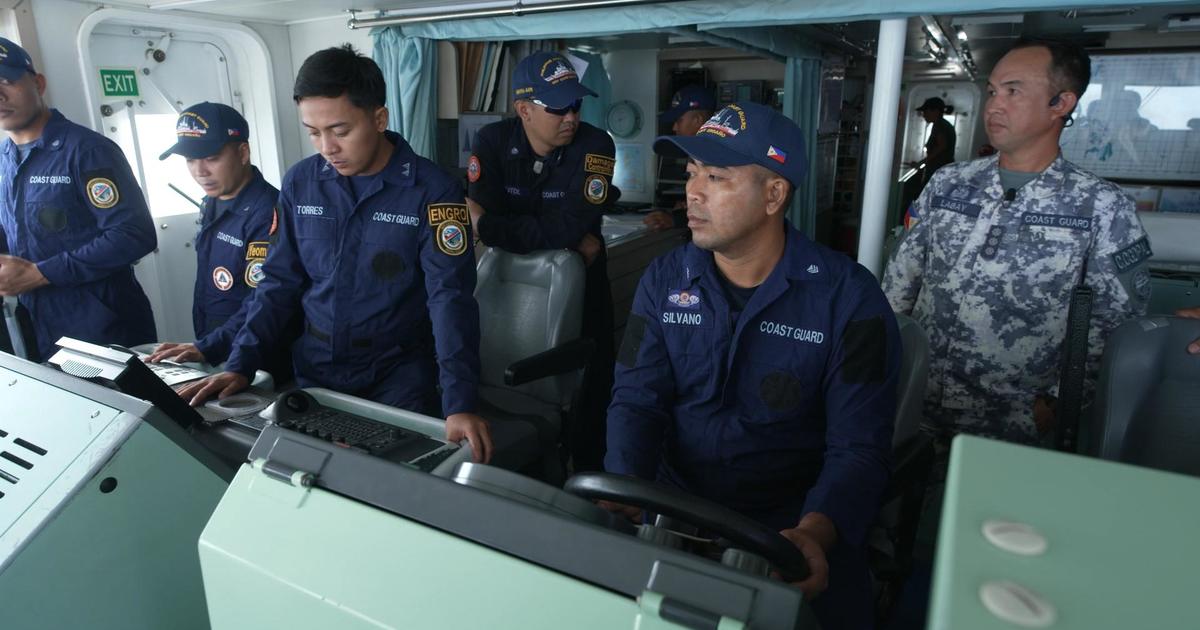An escalating series of clashes in the South China Sea between the Philippines and China could draw the U.S., which has a mutual defense treaty with the Philippines, into the conflict.
A 60 Minutes crew got a close look at the tense situation when traveling on a Philippine Coast Guard ship that was rammed by the Chinese Coast Guard.
China has repeatedly rammed Philippine ships and blasted them with water cannons over the last two years. There are ongoing conversations between Washington and Manila about which scenarios would trigger U.S. involvement, Philippine Secretary of National Defense Gilberto Teodoro said in an interview.
“I really don’t know the end state,” Teodoro said. “All I know is that we cannot let them get away with what they’re doing.”
China as “the proverbial schoolyard bully”
China claims sovereignty over almost all of the South China Sea, through which more than $3 trillion in goods flow annually. But in 2016, an international tribunal at the Hague ruled the Philippines has exclusive economic rights in a 200-mile zone that includes the area where the ship with the 60 Minutes team on board got rammed.
China does not recognize the international tribunal’s ruling.



China has been an outright dictatorship for a while now, it’s just the lifetime leader that was recent.
Words have meanings, and the word you’re looking for is authoritarian, but that doesn’t mean it was a dictatorship.
They were a one party system, that had regularly transitioned power at scheduled intervals for decades. Which means they were not a dictatorship, until Xi stopped those transitions of power.
You’re right, words do have meaning. Just because there is a transition from one dictator to another without bloodshed or death doesn’t mean it isn’t a dictatorship. Just because the dictator of the week is chosen by a committee doesn’t mean it isn’t a dictatorship. One-party systems are commonly accepted to be dictatorships because of the lack of ability by the people to choose their leader, rather it is chosen by the party (usually the party elites).
I know it’s cliche, but I really think you need to go look up the the definition of dictator.
Or, crack a political science 101 book and skip right to the section on political systems.
Or maybe your misunderstanding is just a lack of knowledge of how China’s government structure functioned post-Mao, pre-Xi.
Whatever the reason, I think you need to do a little bit of reading, but it’s not like you’re alone in this misconception so I don’t mean this as an insult.
Do you mean like the summary in Wikipedia? Or how about the Democracy-Dictatorship Index? It seems a lot of people in political circles have been calling China a civilian dictatorship for at least 36 years, just based on the cute little pictures.
Feel free to read a definition that’s more than one sentence long if you want an explanation for something as nuanced as political systems.
Your first link shows exactly why the CCP wasn’t a dictatorship in the era the preceded Xi, and your second link has nothing to do with that era at all.
I have an academic background in this field, so the idea that my understanding is based on reading a single sentence, or a few Wikipedia entries, is amusing.
Here’s a nice simple infographic article that would be a good starting point before jumping into any dry academic readings.
My first link has the following quote:
China has been a one-party state for the last 75 years, so the only question is whether or not it was also a dictatorship.
My second link has an infographic labeling China as a civilian dictatorship in 1988, which is prior to Xi putting himself in absolute authority, so how does it have nothing to do with the era prior to Xi taking absolute authority?
As for the handy little link you provided, that only talks about Xi, and we’re agreed that he is a dictator running a dictatorship, so, while it’s interesting, I’m not sure of the relevance unless your proposal is the the only thing that qualifies as a dictatorship is if it’s run by a single individual. In which case, it seems there are a number of people in your purported field who disagree with that stance.
So…you couldn’t even be bothered to read more than a few paragraphs?
Dictatorships don’t have legal and systemic checks against the autocratic rule, which is why Xi removed them.
You’re using a lot of words, but they’re based on your lack of understanding post-Mao CCP goverence that Xi upended when he seized power.
But I’m done going back and forth on this. You should feel free to go on believing that I am wrong, and that you are right, because I have no confidence that you would read any dry academic writings on the topic that I respond with, as you couldn’t even make it through a few hundred words of a NYT article.
Meanwhile, any question I ask that has a simple answer is ignored. Why was it commonly believed that China was a civilian dictatorship in 1988, more than a few years after Mao and Dengs time? Why is the one-party state of China not considered a dictatorship when one-party states are?
This entire conversation has been moving goalposts, and every time I defined the goalposts clearly enough to not be moved, you simply ran in another direction. I may not have gotten a university degree, but you’ve still done an amazingly poor job of defending your thesis.
I will give you points on the checks and balances applied after Mao reducing the risks of harm from the dictatorship of China, but the definition of a dictatorship doesn’t rely on the benevolence of the leadership, merely the lack of power of the people to change it, which was not negated by dividing the powers of government between different levels.